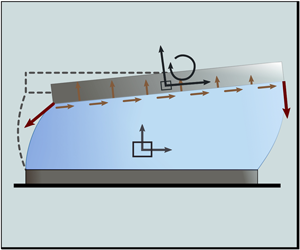Focus on Fluids
Thin-sheet theory for soft materials
-
- Published online by Cambridge University Press:
- 11 January 2021, F1
-
- Article
-
- You have access
- HTML
- Export citation
JFM Papers
Flow criticality governs leading-edge-vortex initiation on finite wings in unsteady flow
-
- Published online by Cambridge University Press:
- 08 January 2021, A1
-
- Article
- Export citation
Flow structure inside and around a rectangular array of rigid emerged cylinders located at the sidewall of an open channel
-
- Published online by Cambridge University Press:
- 08 January 2021, A2
-
- Article
-
- You have access
- Open access
- HTML
- Export citation
Insights into the shockwave attenuation in miniature shock tubes
-
- Published online by Cambridge University Press:
- 08 January 2021, A3
-
- Article
-
- You have access
- Open access
- HTML
- Export citation
Effect of actuation method on hydrodynamics of elastic plates oscillating at resonance
-
- Published online by Cambridge University Press:
- 08 January 2021, A4
-
- Article
- Export citation
Compositional and entropy indirect noise generated in subsonic non-isentropic nozzles
-
- Published online by Cambridge University Press:
- 08 January 2021, A5
-
- Article
-
- You have access
- Open access
- HTML
- Export citation
Two-dimensional modelling of transient capillary driven damped micro-oscillations and self-alignment of objects in microassembly
-
- Published online by Cambridge University Press:
- 08 January 2021, A6
-
- Article
- Export citation
Modelling the flow within forests: the canopy-related terms in the Reynolds-averaged formulation
-
- Published online by Cambridge University Press:
- 08 January 2021, A7
-
- Article
-
- You have access
- Open access
- HTML
- Export citation
Discrete element method–computational fluid dynamics analyses of flexible fibre fluidization
-
- Published online by Cambridge University Press:
- 08 January 2021, A8
-
- Article
- Export citation
Compressibility effects on energy exchange mechanisms in a spatially developing plane free shear layer
-
- Published online by Cambridge University Press:
- 12 January 2021, A9
-
- Article
- Export citation
Collision rate of bidisperse spheres settling in a compressional non-continuum gas flow
-
- Published online by Cambridge University Press:
- 08 January 2021, A10
-
- Article
- Export citation
Theoretical and numerical analysis of the evaporation of mono- and multicomponent single fuel droplets
-
- Published online by Cambridge University Press:
- 08 January 2021, A11
-
- Article
-
- You have access
- Open access
- HTML
- Export citation
The diffusing-velocity random walk: a spatial-Markov formulation of heterogeneous advection and diffusion
-
- Published online by Cambridge University Press:
- 08 January 2021, A12
-
- Article
- Export citation
Thermal boundary layer structure in low-Prandtl-number turbulent convection
-
- Published online by Cambridge University Press:
- 08 January 2021, A13
-
- Article
- Export citation
The effect of streaks on the instability of jets
-
- Published online by Cambridge University Press:
- 08 January 2021, A14
-
- Article
- Export citation
Network broadcast analysis and control of turbulent flows
-
- Published online by Cambridge University Press:
- 08 January 2021, A15
-
- Article
- Export citation
Ensemble average and nearest particle statistics in disperse multiphase flows
-
- Published online by Cambridge University Press:
- 11 January 2021, A16
-
- Article
-
- You have access
- Open access
- HTML
- Export citation
Wave-induced shallow-water monopolar vortex: large-scale experiments
-
- Published online by Cambridge University Press:
- 11 January 2021, A17
-
- Article
-
- You have access
- Open access
- HTML
- Export citation
Zonal jets at the laboratory scale: hysteresis and Rossby waves resonance
-
- Published online by Cambridge University Press:
- 11 January 2021, A18
-
- Article
- Export citation
Spatially evolving cascades in temporal planar jets
-
- Published online by Cambridge University Press:
- 11 January 2021, A19
-
- Article
-
- You have access
- Open access
- HTML
- Export citation













































